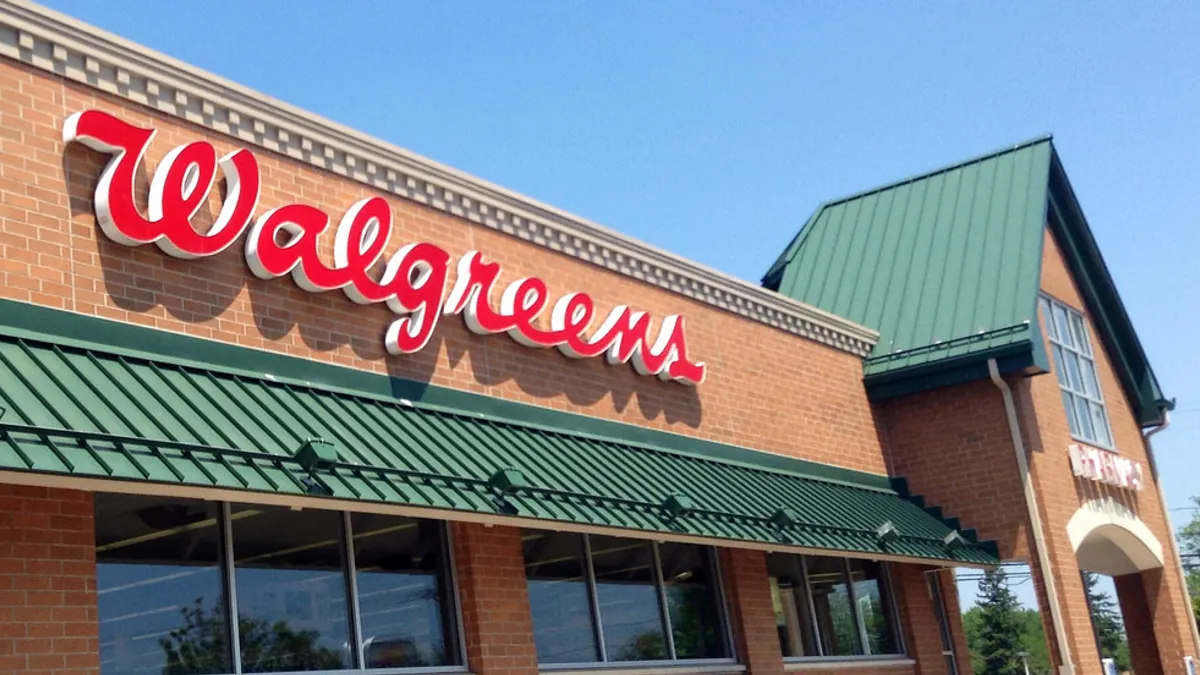Dive Brief:
-
Walgreens on Wednesday reported results for its fourth quarter and fiscal year, noting that GAAP diluted net earnings fell 20% from the year-ago period to 76 cents per share, due to Rite Aid related costs — mainly merger termination fees. Adjusted diluted net earnings rose 22.4% on both an actual and constant currency basis to $1.31 per share, according to a company press release, which beat the Zack’s analyst estimate of $1.22 per share.
-
GAAP net earnings attributable to Walgreens Boots Alliance fell 22.1% to $802 million and adjusted net earnings attributable to Walgreens Boots Alliance rose 18.8% (or 19.1% on a constant currency basis) to $1.4 billion. Sales in the quarter rose 5.3% (or 6.4% on a constant currency basis) to $30.1 billion, beating the Zacks consensus estimate of $30.05 billion, while GAAP operating income decreased 2.3% to $1.1 billion. Adjusted operating income rose 21.2% (or 22.3% on a constant currency basis) to $1.9 billion, the company said.
-
U.S. retail sales fell 3.9% in the fourth quarter compared with the year-ago period, due in part to the closure of certain e-commerce operations, according to the release. Q4 same-store retail sales in the quarter fell 2.1%, partly due to changes in promotional plans, as declines in consumables, general merchandise and personal care were partially offset by growth in the beauty and health and wellness categories. Pharmacy sales rose 12.6% from a year ago and accounted for 72.1% of overall sales primarily due to higher prescription volumes, including mail and central specialty following the formation of AllianceRx Walgreens Prime. Overall sales rose 7.5% from the year-ago quarter to $22.3 billion and same-store sales rose 3.1%.
Dive Insight:
After a tumultuous year jockeying to complete for what ended as a drastically scaled-down acquisition of Rite Aid — just under 2,000 stores for $4.3 billion — Walgreens Boots Alliance ended its fiscal year with mixed results. While its pharmacy business remains robust, its retail sales look "decidedly soft," according to GlobalData Retail analyst Håkon Helgesen.
The retailer is facing challenges overseas, even when currency fluctuations are taken into account — a reflection of the maturity of those markets, especially in the U.K., he noted.
Walgreens will likely see a boost from its acquisition of 1,932 Rite Aid stores, which aren’t yet reflected in its numbers, but that, too, will be a mixed bag in light of the $1.25 billion Walgreens has earmarked for the integration process. That includes capital expenditure on refurbishments and various administrative charges over the next three years, Helgesen noted. "Some of the costs will be offset by $300 million of synergy savings, and we believe Walgreens will be able to boost store productivity and margins thereby giving further buoyancy to the bottom line," he said in a note emailed to Retail Dive. "Even so, we believe this is an acquisition that will take some time before it turns a genuine profit."
While the Rite Aid stores will contribute growth, Walgreens has more to do to improve its retail sales, according to Helgesen. "The acquisition of Rite Aid stores has given Walgreens a strategic play for the next year or so. However, it does not mean that the company can neglect the day-to-day running of the business," he said. "Here we believe much more effort is needed on the retail side where results remain anemic with total sales down by 3.9% and comparable sales reduced by 2.1% in the fourth quarter."
While some of Walgreens' retail weakness was inevitable as it pulled back from e-commerce, its brick-and-mortar performance remains "below par, especially in basic personal care and household essentials," he said. "Here, Walgreens fails to encourage browsing and has more work to do in remaining front-of-mind for such categories."
In contrast to its retail side, Moody's vice president Mickey Chadha believes Walgreens could benefit in the prescription department. "The 8.7% increase in prescriptions filled on a comparable basis to the same quarter ago was primarily due to Medicare Part D and volume growth as the new Walgreens and Prime Therapeutics restricted network prevents CVS Pharmacy's participation in selected fully-insured networks in several key states and in many cases makes CVS Pharmacy a non-preferred provider for Medicare Part D. In total, we estimate this will result in more than 40 million retail prescriptions shifting from CVS into Walgreens stores on an annualized basis," he said in a note emailed to Retail Dive.
Folding in the Rite Aid stores will require scrutiny, though Helgesen expects Walgreens to be on top of that. "An enlarged fleet brings with it the question of optimization," he said. "In this regard, we are encouraged by Walgreens' review of its store operations. Although we do not expect there will be many closures, we do expect the company will find some duplications and will be quick to extract the resultant cost savings."
Walgreens on Wednesday also introduced guidance for adjusted diluted net earnings of $5.40 to $5.70 per share for fiscal year 2018, assuming current exchange rates for the rest of the fiscal year, and continuation of its normal anti-dilutive share buyback program.












